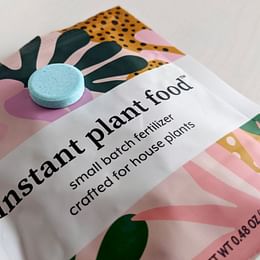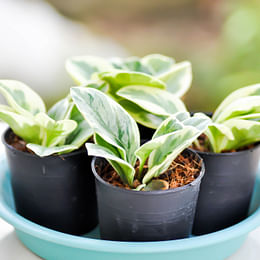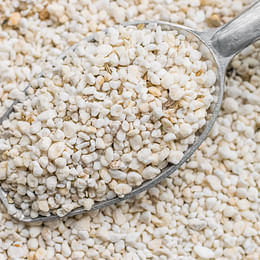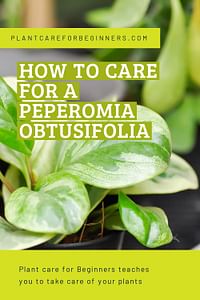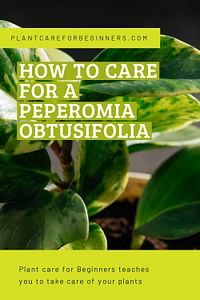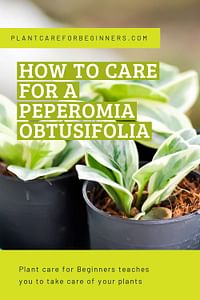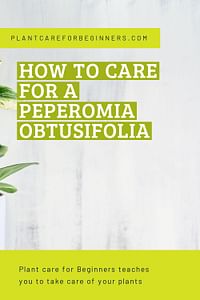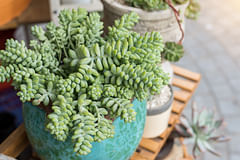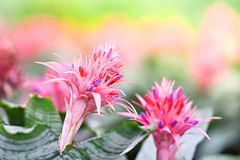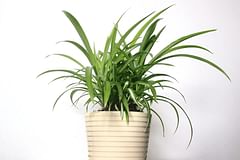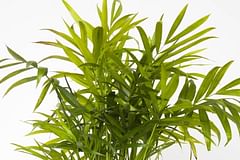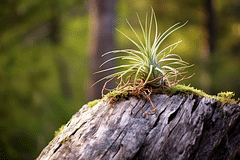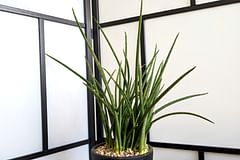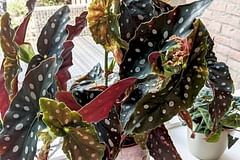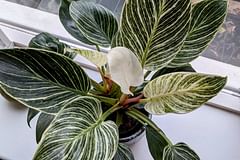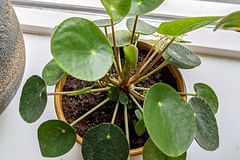How to care for the Peperomia obtusifolia
Get the best tips and tricks on how to care for your Peperomia obtusifolia. Learn what temperature, humidity levels, and soil types work best for your plant, as well as how often you should fertilize or prune it.
Last updated on:
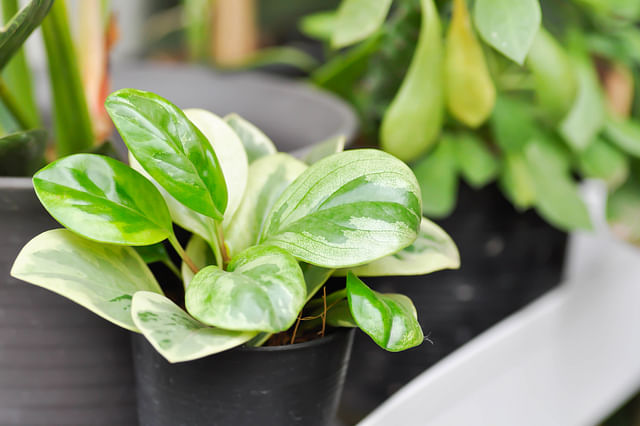
Are you looking for a great-looking plant that's as easy to take care of as a succulent but looks more like a tropical plant? The Peperomia Obtusifolia might be the perfect plant for the job.
Taking care of the Peperomia obtusifolia is a fun experience, even for beginners. It's an easy-to-care-for houseplant that looks great in any room! With just a few simple tips, you'll be able to keep your Peperomia happy and healthy all year round.
In this plant care guide, we're going to look at all the important aspects of taking care of your Peporomia. These are the topics we're going to cover:
Let's get started on your Peperomia obtusifolia journey and learn how to care for this beautiful plant!
How often should you water the Peperomia obtusifolia?
Watering your Peperomia obtusifolia is an important part of keeping it healthy. The thick leaves of the Peperomia hold a lot of moisture, just like a succulent. Its care requirements are similar to that of a succulent as well: it doesn't mind to dry out every once in a while.
As with most houseplants, it's best to water the plant when the soil is mostly dry, as this helps prevent overwatering. To find out if your plant needs watering, feel the top inch of soil in the pot. If it feels dry, your Peperomia is ready for some watering.
Once you've watered the plant, be sure to empty any excess water from the drainage tray or saucer that's underneath the pot. This will help prevent root rot and keep your Peperomia healthy and happy!
When it comes to watering the Peperomia obtusifolia, you should give it just enough water so that the soil is moist for a few days but not soggy. As a rule of thumb, you can water your plant about once a week, which should be plenty for the average temperature and humidity levels.
However, you should adjust your watering if your home is colder or warmer. If it's very hot and dry, then you'll need to water more frequently. On the other hand, if it's cooler and humid, you won't have to water your Peperomia as much.
What are the signs of overwatering for the Peperomia obtusifolia?
One of the most common mistakes beginners make when caring for their Peperomia obtusifolia is overwatering. When too much water stays behind in the soil, it can cause root rot and eventually kill your plant. To prevent this from happening, it's important to watch for the signs of overwatering.
The first sign of overwatering is when the leaves become limp and start to yellow. You may also see brown or black spots on the leaves which are a sign of root rot. Another telltale sign is if the soil in the pot feels soggy, even after a few days without watering.
If you start to see signs of overwatering, then you must adjust your watering schedule. This means cutting back on how often and how much water you give your Peperomia. If there is a lot of root rot already, then you may have to repot your plant in fresh soil to give it a new start.
What are the signs of underwatering for the Peperomia obtusifolia?
The signs of underwatering for the Peperomia obtusifolia are quite similar to those of overwatering: the leaves start to become limp and wilted, and they may also develop brown spots. The key difference is that if you have been under-watering your plant, the soil should feel dry, and the leaves should be shriveled up and crisp.
If you notice that your Peperomia needs more water, then it's time to adjust your watering schedule.
What are the sunlight requirements for the Peperomia obtusifolia?
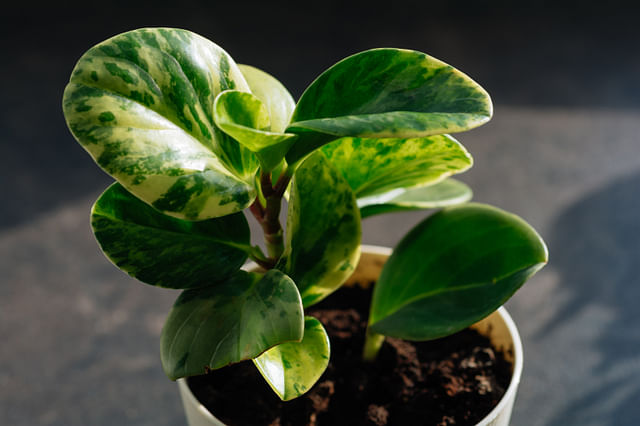
A Peporomia is a plant from the tropics where it grows on the grow. It doesn't get very tall, and usually grows under larger trees. This type of light is easy to recreate in your home because this plant prefers bright, indirect sunlight.
You can give your Peperomia bright, indirect sunlight by placing it near a window but not directly in the sun. Too much direct sunlight can scorch the leaves and damage your plant.
If you don't have any bright spots left for your Peperomia, you can also put it in a low-light spot, as this plant is quite tough and can survive in low to medium sunlight exposure as well.
What are the signs of too much sunlight for the Peperomia obtusifolia?
If your Peperomia obtusifolia is receiving too much sunlight, the leaves may become discolored, turning yellow or brown. You may also notice the tips of the leaves becoming crispy and dried out. In extreme cases, you may see sunburn marks on the foliage.
What are the signs of too little sunlight for the Peperomia obtusifolia?
If your Peperomia obtusifolia is receiving too little sunlight, you may notice the leaves becoming dull and limp. The leaves will also be a lighter shade of green, and growth may become stunted.
Another clear sign that your Peperomia isn't getting enough sunlight is that it may start to stretch out as it searches for more light. You'll also notice the stems become weak and might not be able to support their weight.
If you notice these signs, then it's time to reposition your Peperomia so that it gets more light. Move it closer to a window or add an artificial light source such as a grow light. Doing this will ensure that your plant stays healthy and continues to thrive!
Where should I place the Peperomia obtusifolia in my house?
The Peperomia obtusifolia should be placed in an area that receives bright, indirect sunlight. This means finding a spot near a window where the plant won't get too much direct sunlight. It's important to rotate the plant every few days so all sides of the foliage receive light and the growth is even.
What is the best soil for my Peperomia obtusifolia?
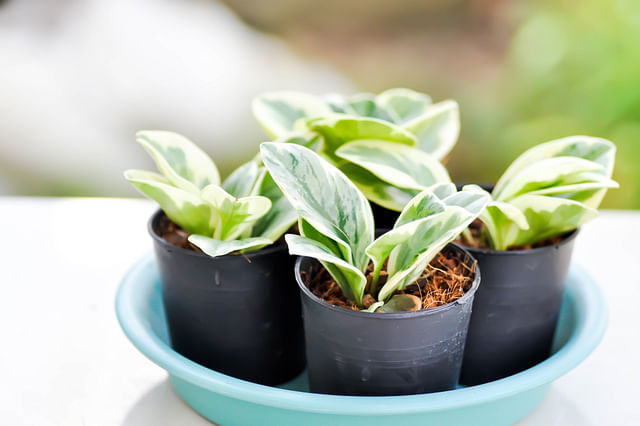
The best type of soil for your Peperomia should be well-draining and nutrient-rich. Look for a soil mix that includes perlite and coconut fibre/coir to help to keep your plant happy. Perlite and coconut fibre/coir help to keep the soil light and airy, while providing excellent drainage.
The coconut fibre/coir helps to hold onto moisture quite well, but also provides the potting mix with structure. This structure is very important because it keeps the soil light and airy for a long time. This is important for proper drainage and the flow of oxygen to your Peperomia's roots. This helps to prevent root rot.
The perlite helps to add drainage to your potting soil. The perlite will drain any excess moisture to the bottom of the pot and away from your plant's roots.
How often should I repot my Peperomia obtusifolia?
As a beginner, it's best to wait until you start seeing roots growing out the bottom of your pot before repotting your Peperomia obtusifolia. This usually happens every 2-3 years. Before that time, it's not necessary (and potentially damaging) to repot your plant every year.
If you're a beginner it's a good idea to wait until the roots are starting to grow out of the pot, because then you can be sure the Peporomia is ready for a larger pot. If you repot earlier, you might put your plant at risk of getting root rot.
If you move your plant to a pot that's too large, the extra soil holds onto too much water for your plant, so it doesn't dry out quickly enough. This put your plant at risk of getting root rot.
After the roots have grown out of their current pot, then you can slowly transition them into a slightly larger and more nutritious potting mix. Doing this once every 2-3 years is good practice for most beginners and will help keep your plant happy and healthy!
What is the ideal temperature range for the Peperomia obtusifolia?
The ideal temperature range for the Peperomia obtusifolia is between 15-24°C (60-75°F). This plant prefers temperatures that are relatively stable and not too extreme. Avoid placing your Peperomia obtusifolia in a drafty location, as this can cause the leaves to dry out and become brown and crispy.
If you live in an area with particularly cold winters or hot summers, it's important to protect your plant from extreme temperatures. You can do this by placing a sheer curtain between the window and your Peperomia or by moving it further away from the window.
How much humidity does the Peperomia obtusifolia need?
The Peperomia obtusifolia prefers a relatively humid environment and does best when the air has a humidity level of around 40-50%. If your humidity levels are too low, you can use a pebble tray to increase the moisture in the air around your plant.
To create a pebble tray for your Peperomia obtusifolia, you'll need a shallow water-resistant tray (such as a shallow pot or dish), some pebbles, and water. Start with filling the tray with the pebbles, then add water to just below the top of the pebble. Place your Peperomia on top of the pebbles and let the water evaporate around the plant.
If you find that the humidity is still too low, there are other tricks such as misting the leaves, grouping plants together and using a humidifier.
How often should you fertilize the Peperomia obtusifolia?
To help your Peperomia grow properly, you should fertilize it during the spring and summer. During the growing seasons, the spring and summer, you should fertilize your plant every month with a liquid fertilizer that is designed for houseplants.
In the fall and winter months, you shouldn't fertilize your plants, as this could put your plant at risk of being over-fertilized. When too much of the fertilizer stays behind in the pot, this could cause a chemical burn on your plant's roots and can kill it if you don't catch it early enough.
If you want to make sure you're not over-fertilizing your Peperomia, you can water your plant thoroughly and let the excess water drain from the drainage hole in the pot. This should flush out most of the excess fertilizer.
What is the best fertilizer for my Peperomia obtusifolia?
The best fertilizer for your Peperomia obtusifolia is a balanced liquid fertilizer that is designed specifically for houseplants. Look for a fertilizer with an N-P-K ratio of 10-10-10 or 20-20-20, as this will provide your plant with all its necessary nutrients.
When you're applying the fertilizer to your plant, always make sure to dilute it with water. You can find instructions on the water-to-fertilizer ratio on the label of the fertilizer. This will help you to feed your plant properly.
How often should I prune my Peperomia obtusifolia?
Pruning your plants is a great way to help your plants keep looking their best. Unlike flowers, you won't have to prune your Peperomia to keep it healthy.
However, you can help to promote growth and make the plant look a little better by pruning dead or dying leaves and stems when you find them. The best part of pruning healthy parts of your plants is that you can very easily propagate this plant from the cuttings you take.
How do you propagate a Peperomia?
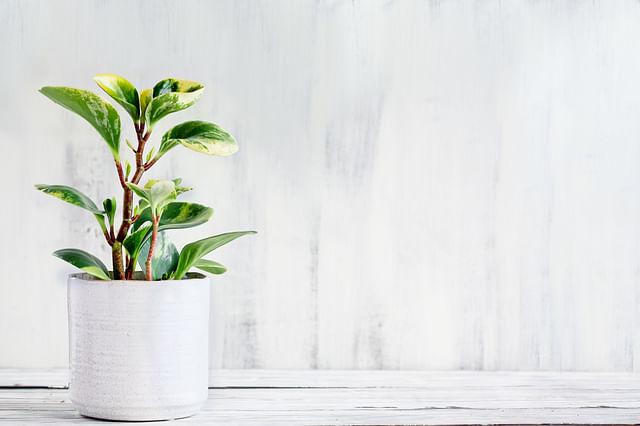
Propagating your Peperomia obtusifolia is a great way to increase the number of plants you have around the house. It's an easy process that beginners can do with just a few simple steps.
First, you'll need to cut stems off your existing plant with sharp scissors or pruning shears. Make sure to use clean tools and sterilize them before use to prevent bacteria from getting into your plant’s wounds. You'll want to make sure each stem cutting has at least two leaves on it as these will help provide energy for root growth.
Once the stems are cut, dip them in either rooting hormone or cinnamon powder (which acts as a natural fungicide). This helps encourage root growth faster and protects against potential fungi infections.
Finally, place the stem in water or potting soil and keep it warm and slightly moist but not soaking wet; this will encourage new roots to grow! Once they're established, you can replant them in individual pots of fresh soil so they can continue growing.
What are common pests for the Peperomia obtusifolia?
Common pests for the Peperomia obtusifolia include spider mites, mealybugs, thrips and scale insects. These pests can be found on the stems and leaves of your Peperomia plants, sucking out the sap and causing discoloration and damage to the leaves.
To prevent these pesky critters from making a home on your plants, it’s important to regularly inspect your Peperomia and check for any signs of pests. If you find any, you should remove them by hand or use an insecticidal soap or neem oil spray.
It's also important to make sure you don't overwater your Peperomia, as this can create the perfect environment for pests to thrive. Keeping your plant in a warm and bright spot is also important, as this will help keep pests away.
Is the Peperomia obtusifolia toxic for cats and dogs?
The Peperomia obtusifolia is not considered toxic for cats and dogs, so it's a great plant to get if you've got pets in your house.
Thank you for reading this post! I hope it helps you to keep your plants healthy and beautiful! If you're looking for more guides on specific plants, you can always request a plant guide to get a guide for the plant you have trouble with.
Tags: beginner-friendly, Plant care tips, pet-friendly
Posted on: Mar 4, 2023